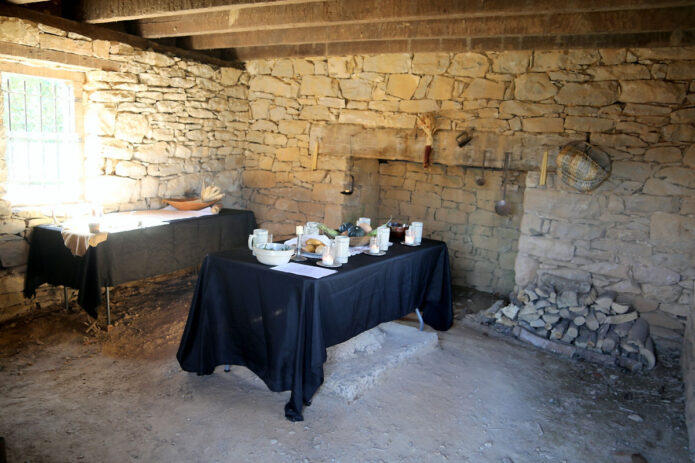 Clarksville, TN – There was some activity at Sevier Station on Saturday when historian Carolyn Ferrell and Jacob Waller donned costumes from the late 1700’s to tell some of the story of Clarksville’s earliest settlers, Valentine and Naomi Sevier, their family, and a handful of other brave pioneers who forged new westward boundaries in very dangerous times.
Clarksville, TN – There was some activity at Sevier Station on Saturday when historian Carolyn Ferrell and Jacob Waller donned costumes from the late 1700’s to tell some of the story of Clarksville’s earliest settlers, Valentine and Naomi Sevier, their family, and a handful of other brave pioneers who forged new westward boundaries in very dangerous times.
Sevier Station is considered Clarksville’s oldest building, dating to 1792. For a few hours on Saturday, Jacob Waller was firing his period-correct musket, dressed as a longhunter of the frontier period.
“They would have gone out hunting pelts. Beaver pelts were worth a lot of money at the time,” Waller said. ” A lot of wealth was created during the 1780’s and 1790’s, and this area was big in the fur trades.
“Settlers weren’t allowed to settle here. This areas was run by the Shawnee, the Cherokee and other tribes. The French themselves had settled Fort Nash, and used these rivers to travel and trade with other outposts and forts. They were hunting this area and sending the pelts back East.”
Sevier Station was settled atop a bluff overlooking the river, which Waller says was a good location for defense and fortification. “This was a Cherokee hunting land,” Waller continued. “It was prime real estate for the Sevier family, but the Native Americans took exception to that. They attempted to clear out the Sevier family, and for the most part they succeeded. But, soon, more settlers came to the area.”
Montgomery County Historian and author Carolyn Ferrell portrayed Naomi Sevier at Saturday’s event.
“This building, built in 1792, is not argued to be the oldest remaining building in Montgomery County, but it is argued whether it is the actual location of Sevier Station,” Ferrell said. “This structure was restored in 1975 by Dan Hanley, Some local historians believe the actual Sevier Station was closer to the bluff, where the spring is located.”
Ferrell has written ten books on our local history and was recently appointed Montgomery County Historian.
“Ive written books on Naomi and Valentine Sevier. I know a little more about it than a lot of folks,” Ferrell said. “In the process of writing these books, I’ve traveled to East Tennessee and visited the important places in their lives, like Kings Mountain where the battles took place, and where they are buried. I like to do my research and go to places where things happened, like Sycamore Shoals and Watauga Settlement.
“I like to portray Naomi from her point of view. She had 14 kids, and no real say in anything. Valentine kept telling her ‘we’re moving west’, and she couldn’t really do anything to stop him. The further west they got, the more peril they were in, and that’s what happened here.”
From Valentine Sevier’s letter to his brother John, December 18th, 1794: “The news from this place is desperate with me. On Tuesday, November 11th, at about twelve o’clock, my station was attacked by about 40 Indians. … Such a scene no man ever witnessed before. Nothing but screams and roaring of guns, and no man to assist me for some time.”

“Sevier had met Doublehead, the Chickamauga Chief, in previous battles, killing members of his family, and that’s why he came after Sevier,” Ferrell said. “It was a revenge thing. They scouted Sevier Station for weapons and to see how many men were still around. The next day, they attacked. Valentine was warned of the day and time of the impending attack, but he just didn’t believe it.
“His pride had him thinking that being “the great Indian hunter” that he was, nobody would dare attack him. He suffered for it on November 11th 1794. There were at least five cabins a blacksmith shop, and some outbuildings here on 640 acres. This was probably a temporary stop for Sevier, like all the other previous stops he had made, as he continued to move west.”
Ferrell said Sevier’s goal was to build up a settlement that could be sustained as he continued his journey west.
“The bigger plan was, once enough settlers had moved into this area, they would be able to separate from North Carolina and form their own state, Tennessee,” Ferrell said. “He was on a mission from his brother John Sevier, who became the first Governor of Tennessee. John kept encouraging his brother to move west while he stayed in East Tennessee where it was nice and safe.”
You can contact Montgomery County Historian Carolyn Ferrell through the Mayor’s office. Her latest book is “We Wait Beneath the Furnace Blast” which documents the history of the Southern parts of Montgomery County.
For a more detailed account of the Autumn 1794 raid at Sevier Station, check out Tracy Jepson’s article Clarksville Beginnings – Part 2: Revisiting the Massacre at Sevier Station; In Their Own Words.


